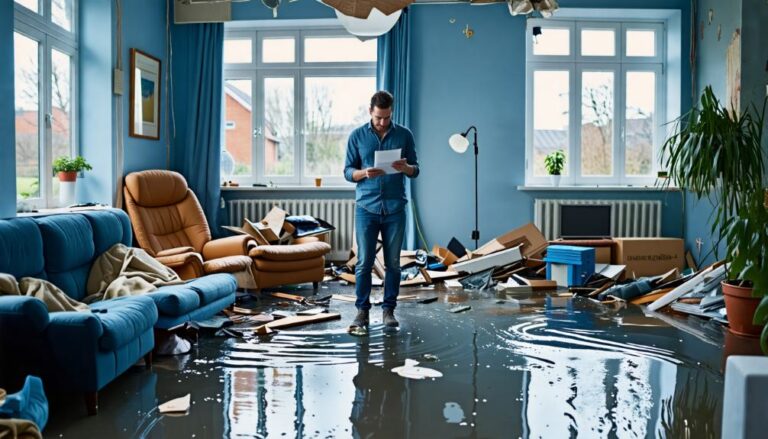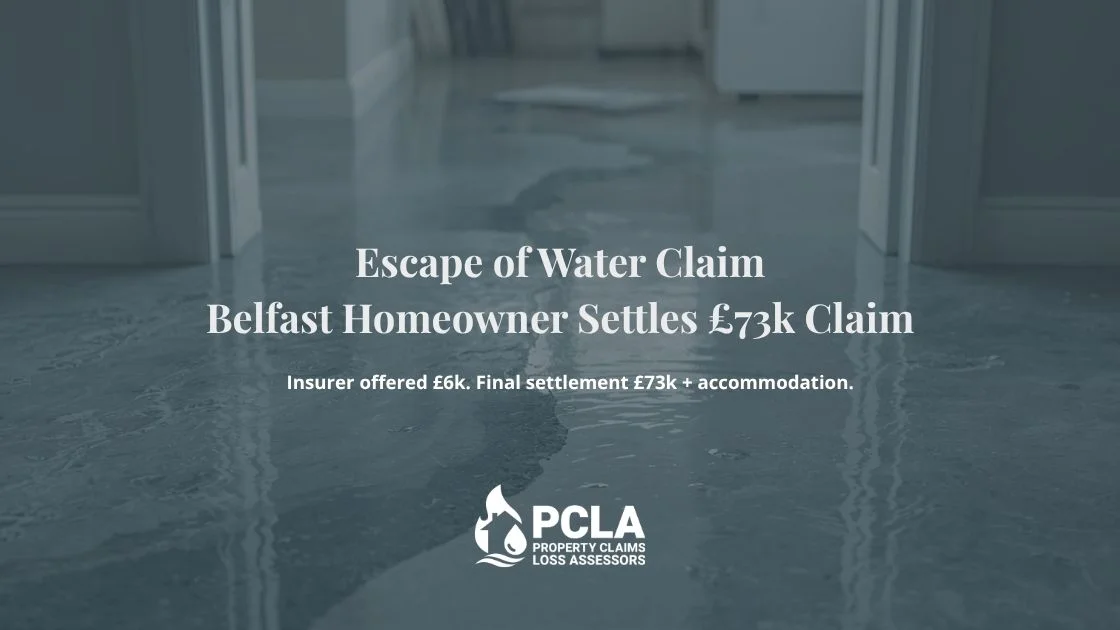Dealing with water damage in your UK home can be quite a challenge, but knowing the right steps to take can significantly improve your chances of a successful insurance claim. Read on to find out our water damage insurance claim tips.
Firstly, report the damage promptly to your insurer and take immediate action to prevent further damage.
Document everything meticulously, including photographs and videos of the damage, and compile a detailed inventory of affected items.
Retain all receipts related to the damage and consider seeking professional assistance from a loss assessor.
By following these steps, you’ll be well on your way to a smoother claims process and a quicker return to normalcy.
Report the damage promptly
Reporting water damage promptly is vital, and this process begins with notifying your insurance company within 24 hours of discovering the damage to confirm compliance with policy requirements.
We recognise that dealing with water damage can be overwhelming, but taking this important step can make all the difference in the claims process. By reporting the damage promptly, you not only guarantee a smoother experience but also increase the chances of a successful claim.
Your insurance company may have specific procedures in place for handling water damage claims, and notifying them within the specified timeframe allows them to guide you through the next steps.
This prompt notification also demonstrates your commitment to mitigating further damage to your property, which can work in your favour during the claims assessment.
Document everything
Thorough documentation is essential to a successful water damage insurance claim, and this process begins with capturing a comprehensive visual record of the damage. To document everything, start by taking clear and extensive photographs and videos of the source of the leak, the resulting damage, and any affected belongings.
This visual evidence will strongly support your claim and assist in assessing the damage. Ensure that you also capture images of any affected areas, including walls, ceilings, and floors, as well as any damaged personal items.
When documenting the damage, be sure to identify the source of the leak, as this will help determine the cause of the damage and facilitate a successful payout.
It is also vital to keep a record of all correspondence with your insurer and any relevant receipts or invoices. By thoroughly documenting the damage, you will be able to file a claim that accurately reflects the extent of the damage and increases the likelihood of a successful outcome.
Mitigate further damage

Prompt action is necessary to minimise further damage, and homeowners should take immediate steps to prevent additional harm to their property.
Once the source of the damage is identified, take steps to mitigate further damage, such as shutting off the water supply or containing the affected area. This will not only prevent additional damage but also demonstrate to your insurer that you have taken reasonable action to reduce the resulting harm.
Be sure to document these efforts, as this can be useful when making your claim. By taking swift action, you can help reduce the costs and stress associated with the claims process.
Preventing further damage is an ongoing process that requires regular monitoring of the affected area.
Keep an eye out for any signs of additional damage, such as water spots or structural issues. Remember, your goal is to minimise the damage and make the claims process as smooth as possible.
Create a detailed inventory
Once you have taken steps to mitigate further damage, attention should be focused on creating a comprehensive inventory of the items affected by the water damage, which will serve as an important component of your insurance claim.
This detailed list will assist you in claiming for contents damage and ensure that you receive fair compensation to cover the cost of repairs or replacements.
When compiling your inventory, be sure to include the estimated value and age of each item, as this information will be vital in determining the extent of the damage.
Keep all receipts

As you navigate the insurance claims process, it is essential to retain all receipts for expenditures incurred due to the water damage, including those for emergency repairs, temporary accommodation, and other related expenses. These receipts will serve as significant documentation when filing a claim, helping to ensure a successful water damage claim. Make sure you document every purchase, no matter how small, as it can add up quickly.
Keeping receipts will also help you keep track of your expenses, making it easier to stay organised and focused on getting your life back to normal. Remember, your insurance policy covers you for these types of expenses, so don’t hesitate to keep receipts for everything from hotel stays to replacement clothing.
By keeping all receipts, you’ll be able to demonstrate the full extent of your losses and obtain the compensation you deserve. This will enable you to keep your home safe and secure, minimising the disruption caused by the water damage.
Understand your policy
Thoroughly understanding the terms and conditions of your insurance policy is vital to successfully navigating the water damage claims process and ensuring that you receive the compensation to which you are entitled.
Home insurance policies cover various aspects of water damage, but it is imperative to know what is included and what is not. Take the time to review your policy and familiarise yourself with the following key points:
- What’s covered: Check if your policy includes coverage for escape of water, such as burst pipes or overflowing appliances.
- Limits and exclusions: Understand any limits on trace and access services or specific exclusions, like damage caused by maintenance-related issues.
- Claim procedures: Know the steps to take when filing a water damage claim, including notification requirements and documentation needed.
Consider professional help
In cases where the damage is severe or the claims process appears complex, seeking the expertise of a professional loss assessor can be a valuable step in ensuring that your claim is handled efficiently and effectively. If the damage is extensive, consider hiring a loss assessor to manage the claims process on your behalf. They can provide expert guidance and negotiate with the insurer to achieve the best possible outcome for your insurance claim.
| Benefits of Hiring a Loss Assessor | What They Can Do | Why It Matters |
|---|---|---|
| Expert Guidance | Provide advice on the claims process | Reduces stress and uncertainty |
| Claim Preparation | Gather and organise evidence | Strengthens your claim |
| Negotiation with Insurer | Advocate on your behalf | Increases chances of fair settlement |
| Claim Settlement | Facilitate a smooth resolution | Gets you back on track quickly |
| Peace of Mind | Handle all communication with the insurer | Allows you to focus on recovery |
Prepare for the loss adjuster
Preparing to meet with the loss adjuster requires gathering and organising all relevant documentation and evidence to support your water damage insurance claim. This is an essential step in ensuring that your claim is processed smoothly and that you receive the compensation you deserve.
As you prepare for the loss adjuster, keep in mind that their role is to assess the damage and determine the extent of the insurer’s liability.
Here are three essential tips to keep in mind:
- Be thorough: Ensure you show the loss adjuster all the evidence you’ve gathered, including photographs, videos, and written assessments from professionals.
- Be organised: Keep all your documentation and evidence in a neat and organised file, making it easy for the loss adjuster to review.
- Be prepared to answer questions: The loss adjuster will likely ask you questions about the incident, so be ready to provide a detailed account of what happened.
Negotiate for flood-resilient repairs
One key aspect to contemplate during the claims process is negotiating with your insurer to incorporate flood-resilient repairs into the settlement, which can help mitigate potential future damage and reduce claim costs.
When you negotiate for flood-resilient repairs, you’re not only ensuring your home is better equipped to handle future flooding, but also demonstrating your commitment to limiting the damage. This proactive approach can lead to a more favourable outcome for your claim on your home insurance.
It’s essential to discuss the installation of flood-resilient fixtures and fittings with your insurance agent, highlighting the long-term benefits of such measures.
Argue that by investing in flood-resilient repairs, you’re reducing the likelihood of future claims, ultimately saving the insurer money. By working together, you can find a mutually beneficial solution that addresses the flood damage while also providing a safer and more resilient living space.
This collaborative approach can lead to a more successful claim and a stronger sense of belonging in your home.
Be persistent and keep records
By advocating for flood-resilient repairs and presenting a well-supported claim, you have laid the groundwork for a successful settlement.
It is now equally essential to be diligent in your record-keeping and follow-through to ensure that your claim is processed efficiently.
Making an insurance claim for water leak damage can be a lengthy and sometimes frustrating process, but with persistence and proper claims management, you can stay on top of your claim and achieve a fair settlement.
Here are three reasons to be meticulous about record-keeping:
- Avoid missed deadlines: Stay on track and respond promptly to requests from your insurer to prevent delays in your claim.
- Support your case: Keep detailed records of all communications, including dates, times, and content of phone calls or emails, to build a strong foundation for your claim.
- Stay organised: Maintain a central file of all claim-related documents, receipts, and correspondence for easy reference and updating as needed.
Conclusion
By following these water damage claim tips you can be sure to give yourself the best chance of success.
Effective management of water damage insurance claims in the UK relies on prompt action and thorough documentation.
By adopting a proactive approach, property owners can navigate the complexities of claims with greater ease.
As the saying goes, ‘a stitch in time saves nine’; timely intervention can mitigate further damage and promote a swift resolution.
By following the outlined tips, individuals can optimise their claims process, ensuring a more favourable outcome and a speedy return to normality.



